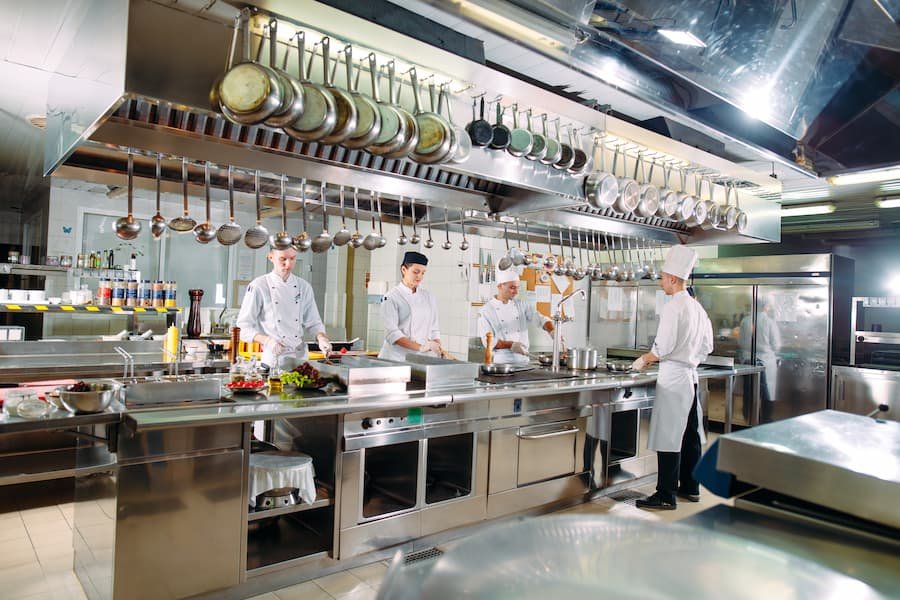In the last few years, the food delivery business has completely changed as the demand grows significantly. The reason being customer tastes, new technology, and the never-ending quest for operational efficiency. The cloud kitchen idea or also acknowledged as ghost kitchens, is one of the biggest changes in the world of food delivery businesses. In fact, it has pushed up the demand for the food delivery app development services as delivery-only businesses have quickly become popular, and they are changing the way restaurants work. It makes it very easy for the customers to get their food. If you are thinking about investing in the respective domain, then here we are to help you with all the clarity. Read on.
Cloud Kitchen: What You Must Know?
A cloud kitchen is a place where food is made for delivery or takeout only, with no opportunity for customers to eat in. Unlike traditional restaurants, cloud kitchens do not require prime real estate or elaborate interiors. Instead, they focus on making kitchen operations as efficient as possible and using technology to quickly fill online orders. Cloud kitchens usually work in one of three ways:
- Single-brand cloud kitchens
- Multi-brand cloud kitchens
- Aggregator-managed cloud kitchens
People order food through apps or websites, which then send the orders to the kitchen, where they are made and sent out by delivery partners. Digital platforms streamline the whole process, making cloud kitchens very efficient and able to grow.
How Cloud Kitchen Concept Boosting Food Delivery Business Today?
Cloud kitchens are leading the way in the meal delivery boom since they provide a lot of benefits that regular restaurants can’t match. This is how they are changing the business:
Lowering Operational Costs
Cloud kitchens do away with the need for pricey real estate, fancy decor, and a lot of staff. They cut their overhead costs by a lot by only focusing on making and delivering food. This lean methodology lets organizations put more money into high-quality ingredients, marketing, and technology. Lower expenses also mean lower prices for buyers, which drives up demand even further.
Enhancing Delivery Speed
Cloud kitchens can fill orders faster than regular restaurants because they are located in busy urban areas or near groups of residential communities. Their design makes it easy to prepare meals quickly and give them off to delivery drivers. This speed is important for matching customer expectations for quick meal delivery, which is a big difference in today’s market.
Enabling Brand Diversification
Cloud kitchens let business owners and well-known brands open many virtual restaurants from one place. For instance, one kitchen can make burgers, pizzas, and Asian food at the same time, but they will all be named differently. This method makes the most of the cooking space, meets the needs of a wide range of customers, and lets you quickly try out new ideas, all without the risk and cost of creating separate stores.
Streamlining Order Management
Cloud kitchens get orders from a lot of different places, so they need integrated order management systems to keep track of and prioritize requests. These techniques cut down on mistakes, speed up the prep time, and make everything work better. The seamless integration with food delivery app development services makes sure that orders are handled seamlessly from when they are received to when they are shipped.
Expanding Market Reach
Cloud kitchens may instantly start up shop in new areas or towns without the hassle of setting up traditional restaurants. They can reach more customers by using on-demand app development services, which lets them reach groups of people they couldn’t before. This flexibility is especially useful in a market that changes quickly.
Advantages of Cloud Kitchens Over Traditional Restaurants
Cloud kitchens have a lot of benefits over traditional restaurants, which makes them a good choice for both new and established businesses.
Minimal Investment
It costs a lot of money to open a traditional restaurant, including the site, the decor, and the staff. Cloud kitchens, on the other hand, work out of small spaces, usually in less expensive places. This cuts down on the initial costs of starting a food business by a lot.
Maximum Flexibility
Cloud kitchens may quickly change to fit new market trends. You can change the menu, start new brands, and change the size of your business with little trouble. This flexibility is a big plus in the fast-paced world of food delivery.
Higher Margins
Cloud kitchens can make more money by lowering their costs and focusing on delivery. The money saved on rent, utilities, and front-of-house staff goes straight to the bottom line.
Quick Scalability
The cloud kitchen model can easily grow. Successful firms may quickly and efficiently set up shop in new places by using the skills of a custom mobile app development company to streamline processes and keep things the same across all of their locations.
Reduced Risk
Cloud kitchens are less risky financially than regular restaurants because they have reduced start-up expenses and let you try out new ideas rapidly. If a menu or brand isn’t doing well, it can be changed or replaced without losing a lot of money.
Top Reasons Why Food Delivery Thrives with Cloud Kitchens
Convenience is King
People who buy things today care most about how easy it is to get them. Cloud kitchens provide restaurant-quality meals right to customers’ doors by working well with food delivery app development services. This means that customers don’t have to go out to eat or cook at home.
Multiple Choices Under One Roof
Cloud kitchens usually have more than one brand, so clients can order a lot of different types of food at once. This “one-stop-shop” approach makes food delivery platforms more appealing and encourages people to place bigger, more frequent purchases.
Hyper-local Fulfillment
Cloud kitchens make sure that food comes hot and fresh by putting kitchens near places where people want to eat. This hyper-local strategy cuts down on delivery times and makes customers happier, which is an important part of developing loyalty.
24/7 Availability
Cloud kitchens can be open all the time, unlike regular eateries that have set hours. This longer availability meets the needs of shift workers, late-night desires, and a wide range of customers, which increases the number of orders even more.
The Role of Technology in Cloud Kitchen Operations
Technology is the foundation of the cloud kitchen model. It makes things more efficient, scalable, and better for customers. This is how technology makes modern cloud kitchens work:
Kitchen Display Systems (KDS)
KDS screens take the place of traditional ticket systems. They show orders in real time and sort them by delivery date. This cuts down on mistakes, speeds up the process of getting ready, and makes sure that every meal is cooked to order.
Order Aggregators Integration (Zomato, Uber Eats, etc.)
Cloud kitchens work with big meal delivery services so that they can get and handle orders from many different places all in one spot. This integration, which is typically made easier by on demand app development services, makes operations more efficient and increases the number of orders.
Real-time Inventory Tracking
Advanced inventory management systems keep track of how much of each item is used, let workers know when stock is low, and automatically reorder. This cuts down on waste, keeps expenses in check, and makes sure that popular menu items are constantly on hand.
Delivery Route Optimization
Advanced algorithms look at traffic patterns, order locations, and delivery timetables to find the best routes for drivers. This makes deliveries faster, saves money on gas, and makes the whole experience better for customers.
Data Analytics for Customer Behavior Insights
Cloud kitchens use data analytics to learn what customers want, guess what they’ll want in the future, and tailor their marketing. These statistics give you useful information that can help you improve your menus, run targeted specials, and make your business run more smoothly.
Final Thoughts
Hopefully you have got complete clarity about the world of cloud kitchens. They have certainly become one of the primary aspects of meal delivery. In fact, one of the major attributes of cloud kitchens are helping businesses compete by using technology, cutting expenses, and making operations run as smoothly as possible.
So, cloud kitchens are not just a fluke attribute of food delivery development, they are changing the way we think about restaurants, delivery, and even the act of eating. They have a big and lasting effect on the food delivery sector, giving us a model for how to be creative and successful in the digital age.

